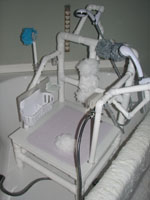Designers: Robert Buechler, Aaron Carlson and Lenny Slutsky
Supervising Professor: Larry Bohs
 INTRODUCTION
INTRODUCTION
Our client, an 8-year-old boy with Thrombocytopenia Absent Radius (TAR) Syndrome, could not bathe independently because his arms are weak and very short. The Bath Chair has a PVC frame and mesh bath sponges as washing surfaces. A shower caddy is mounted to a safety railing on the right side of the chair, and showerheads attach to the top of the chair and to a safety railing on the left side. The client controls water flow for each showerhead using two push-button valves on a diverter. Using the chair, the client can now bathe independently.
SUMMARY OF IMPACT
The client previously needed help from his parents to bathe, but now can bathe by himself. His mother commented, “This is a huge step for (him) in terms of personal care for himself. … I can’t put into words the joy it makes me feel seeing him excited about gaining this independence.”
TECHNICAL DESCRIPTION
The frame of the Bath Chair (Figure 1) is made from 11/2″ furniture-grade PVC pipe. The base is rectangular and has two layers. The bottom layer is for structural support, and the top layer, which contains an extra horizontal crossbar, supports the seat. Safety rails on each side of the seat are made from 1″ PVC.
Two showerheads are mounted to the frame of the chair: one at the top of the seat back, and one on the left safety railing. A flexible hose attaches to the tub faucet via a threaded fitting. This hose is connected to a diverter valve, which connects to hoses for two showerheads. Each showerhead attaches to the frame on a rotating showerhead mount. A handle made from 3/4″ PVC pipe with a PVC tee attaches to each rotating mount, allowing the client to control the direction of water flow. The diverter has an on/off switch for each branch, which allows him to control the water supply to each showerhead.
 The seat is made from 1/2″ thick High Density Polyethylene with smooth routed edges, and is secured to the base with countersunk flat-head stainless steel machine screws. The top of the seat is covered with a ComfortArt™ Plus Non-Slip Bath Mat (Griptex), which gives the seat a comfortable, non-slippery surface. Small holes drilled through the seat prevent pooling of water. An acrylic sheet attached to the right safety railing provides a convenient location for bathing accessories. A shower caddy, which holds soap, shampoo, and a cup that our client uses for rinsing, is mounted to the acrylic sheet, along with a soap dish. Bath sponges attached to the frame of the chair to allow him to wash different parts of his body by rubbing: two sponges on the top bar for his head, three on the middle vertical bar on the back for his back, and one on the seat for his groin area and backside. Each bath sponge attaches to the frame using a custom attachment system, which consists of an ovular acrylic sheet with two acrylic disks secured to one side using rivets. The result is similar to the clasp of a manila envelope, and holds the bath sponge tightly when the sponge’s strings are wound around the disks. This system gives makes the sponges secure but also easy to replace.
The seat is made from 1/2″ thick High Density Polyethylene with smooth routed edges, and is secured to the base with countersunk flat-head stainless steel machine screws. The top of the seat is covered with a ComfortArt™ Plus Non-Slip Bath Mat (Griptex), which gives the seat a comfortable, non-slippery surface. Small holes drilled through the seat prevent pooling of water. An acrylic sheet attached to the right safety railing provides a convenient location for bathing accessories. A shower caddy, which holds soap, shampoo, and a cup that our client uses for rinsing, is mounted to the acrylic sheet, along with a soap dish. Bath sponges attached to the frame of the chair to allow him to wash different parts of his body by rubbing: two sponges on the top bar for his head, three on the middle vertical bar on the back for his back, and one on the seat for his groin area and backside. Each bath sponge attaches to the frame using a custom attachment system, which consists of an ovular acrylic sheet with two acrylic disks secured to one side using rivets. The result is similar to the clasp of a manila envelope, and holds the bath sponge tightly when the sponge’s strings are wound around the disks. This system gives makes the sponges secure but also easy to replace.
Figure 2 shows the client using the Bath Chair. Cost of parts for the device was approximately $500.